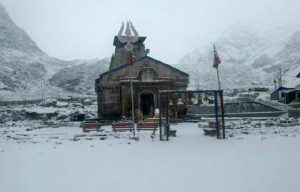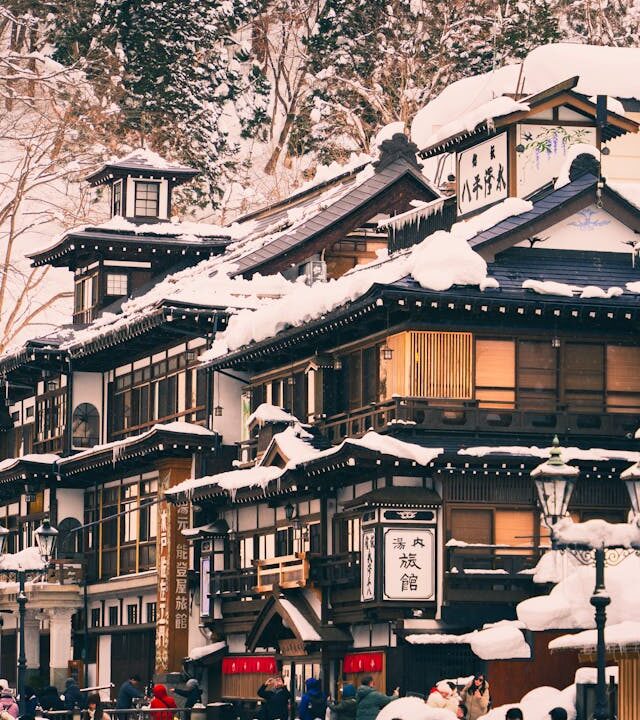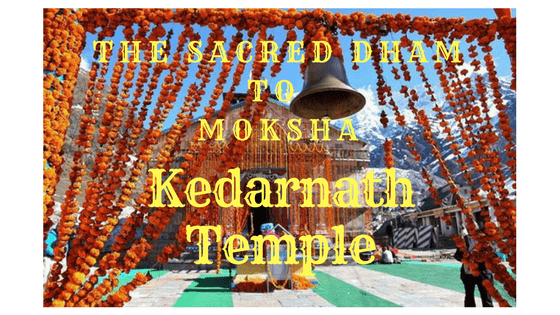Across India, there are twelve Jyotirlinga. It is expounded in Shiv Purana that Lord Shiva would specifically stay at 12 different locales as eternal Jyoti. Being able to visit each of these Jyotirlinga is considered to be such a blessing. At Kedarnath rests the pristine Jyotirlinga, one of the twelve across the Indian subcontinent. No wonder thousands of pilgrims brave the difficult terrain of its trajectory to reach Kedarnath. Paying one’s obeisance at Kedarnath Temple would require the pilgrim to trek uphill for about 19 km from Gaurikund. You could well consider the perils of the journey as a metaphor for one’s inner struggles before letting the inner Divine fully take the lead in one’s life. Or is akin to Maa Parvati’s rigorous spiritual practice to win over Lord Shiva as her husband, which she undertook in Gauri Kund.

The temple is located near the banks of the Mandakini River in the Garhwal Himalayas of Uttarakhand. The temple similar to sacred shrines located in icy cold Himalayan terrain opens for darshan only six months a year. It remains open from Akshaya Tritiya (April) till Kartika Purnima (November). The idol is transferred to Ukhimath Omkareshwar Temple during the winter to ensure the continuance of Pooja rituals throughout the year.
History
The beautiful stone edifice of the temple standing on a plateau amidst snow-clad mountains dates back to the eighth century BCE. Although, the temple of Kedarnath is believed to have been first built by Pandavas in Dwapara Yuga.
There’s an interesting tale linking its conception with the Pandava brothers in which the five brothers were struck with intense remorse at their having murdered their own family members in the bloody Kurukshetra war. Upon being advised to seek forgiveness from Lord Shiva and the Lord eluding them in spite of their arduous search for them, their curiosity was piqued by encountering a certain bull. Bhim is said to have engaged in forced combat with the bull at the end of which the bull dived into the ground. This left its posterior, hump above the surface. Actually, Lord Shiva had only taken the shape of the bull to delude himself from the Pandavas. It is said that different body parts of the bull became visible at different sites in the Garhwal Himalayas, each of whom Pandavas raised a temple in honor of Shiva and prayed for redemption. Lord Shiva is said to have been pleased with their penances and freed them from their karmic sins.
How to Reach-
If you prefer to travel by road, you can travel towards Kedarnath from any of the adjacent major cities and/or pilgrimage stopovers like Delhi, Rishikesh, Nagpur, Haridwar, Mussoorie, and Chandigarh. Once one reaches Sonprayag/Gaurikund, the next phase of the journey begins – an uphill trek of 16-19 Km to the sacred shrine.
One can remit the strenuous effort involved in reaching Kedarnath by opting for helicopter services to Kedarnath. The helicopter service usually begins from Sahastradhara Helipad at Dehradun.
Sightseeing:
The trail from Gaurikund to Kedarnath would let one into intimate encounters with Himalayan topography. The trail is not just a mere test of one’s physical endurance but also of one’s spiritual ardor. If not for the unadulterated mountainous beauty that accompanies one’s ascent up the trail, hardly would have anyone had the motivation to persist in finishing the trek.
Other than the Kedarnath shrine, one also ought to pay obeisance at Bhairavnath Temple. The temple housing the fierce form of Lord Shiva is worshipped as the guardian deity in the entire area. The panorama from the temple’s premises of the entire Kedar Valley is utterly mesmerizing.
Accommodation
There is provision for temporary accommodation near the temple premises in the form of tent houses and a few guesthouses. It is thereby advisable to finish the Darshan and return downhill to stay in any of the hotels in the Kedarnath Temple area.
Best Time to Visit

Of the six months, the temple remains open for Darshan; it is advisable to avoid travel plans during monsoon season. Thus, the best time to procure blessings of Kedarnath includes May, June (pre-monsoon), September (post-monsoon), and October.
You may also like to read Kailash Mansarovar











April 17, 2018
5
April 17, 2018
5